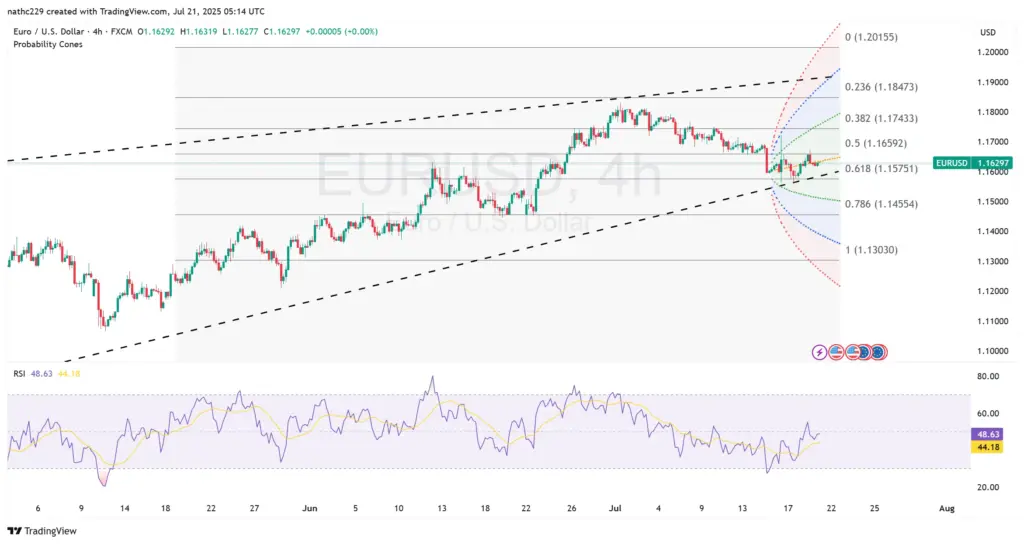EUR/USD Poised for Recovery as Dollar Weakness Emerges from Dovish Fed Stance

Overview
EUR/USD demonstrated resilience on Friday, rebounding from recent lows to hold gains around 1.1627 amid declining U.S. Treasury yields and ongoing tensions between President Trump and the Federal Reserve. This recovery suggests a potential turning point, with recent dovish remarks from Fed officials and mixed U.S. economic data softening the dollar's outlook. Traders now focus on technical levels and forthcoming economic data to determine whether EUR/USD can sustain its bullish momentum.
Technical Outlook
EUR/USD found significant buying interest around the psychological support at 1.1600, rebounding strongly from Friday’s session low and subsequently consolidating gains in the afternoon session. Trading remained confined between an intraday high of 1.1672 and a low of 1.1627, reflecting cautious yet constructive market sentiment.
Key resistance is clearly marked by Friday's high at 1.1672, a level that traders will closely watch for potential breakout confirmation. Should the pair surpass this resistance decisively, it would set the stage for a retest of the recent high of 1.1830 from July 1, and subsequently challenge the upper Bollinger Band near 1.1853.
Critical support lies initially at 1.1600, followed by Thursday’s low at 1.1556. These levels represent essential technical barriers to further downside. A breach below 1.1556 would open potential declines toward the robust support provided by the rising 55-day moving average at 1.1481.
Technical momentum indicators have turned cautiously bullish, reflecting the recent rebound. Stabilizing RSI readings and supportive technical formations indicate a potential shift from bearish sentiment to neutral or bullish bias.
Economic Indicators and Market Drivers
The recent bounce in EUR/USD is primarily driven by the shifting market perception of U.S. monetary policy. Dovish statements from prominent Fed policymakers—particularly Mary Daly and Christopher Waller—have suggested potential near-term rate cuts, thus reducing the dollar's yield advantage.
June’s revised U.S. retail sales data, revealing modest real-term growth, have also supported this narrative. These indicators suggest the Fed may refrain from aggressive monetary tightening, contributing to downward pressure on U.S. Treasury yields and consequently aiding EUR/USD.
Additionally, ongoing public criticism from President Trump toward the Federal Reserve has introduced significant uncertainty, further depressing the dollar and benefiting the euro. Market expectations for future Fed policy have shifted slightly lower, as seen in LSEG’s IRPR data, which points to a less aggressive rate hike path through year-end 2025.
Risks and Potential Consequences
EUR/USD remains subject to several risks, notably geopolitical tensions and economic uncertainty. Continued trade frictions between the U.S. and Europe present a meaningful risk to the Eurozone’s economic stability. Any negative developments in this area could swiftly reverse recent bullish gains.
Moreover, upcoming U.S. economic data, particularly employment and inflation reports, could alter market expectations around Fed policy. Stronger-than-expected figures might revive the dollar’s strength, undermining recent EUR/USD gains.
Technically, maintaining support at 1.1600 and 1.1556 is crucial. Failure to sustain these levels would indicate renewed bearish momentum, targeting deeper technical supports near 1.1481.
Strategic Recommendations
Bullish traders should closely monitor resistance at 1.1672 for breakout opportunities. Stops should be placed cautiously below recent supports to manage downside risk effectively.
Bearish traders must watch for potential reversals near current resistance or confirmatory breaks below key supports to justify positioning.
Conclusion
EUR/USD's recent recovery highlights shifting market sentiment driven by dovish Fed signals and supportive technical indicators. Traders must remain attentive to evolving economic data and geopolitical factors to navigate effectively.
